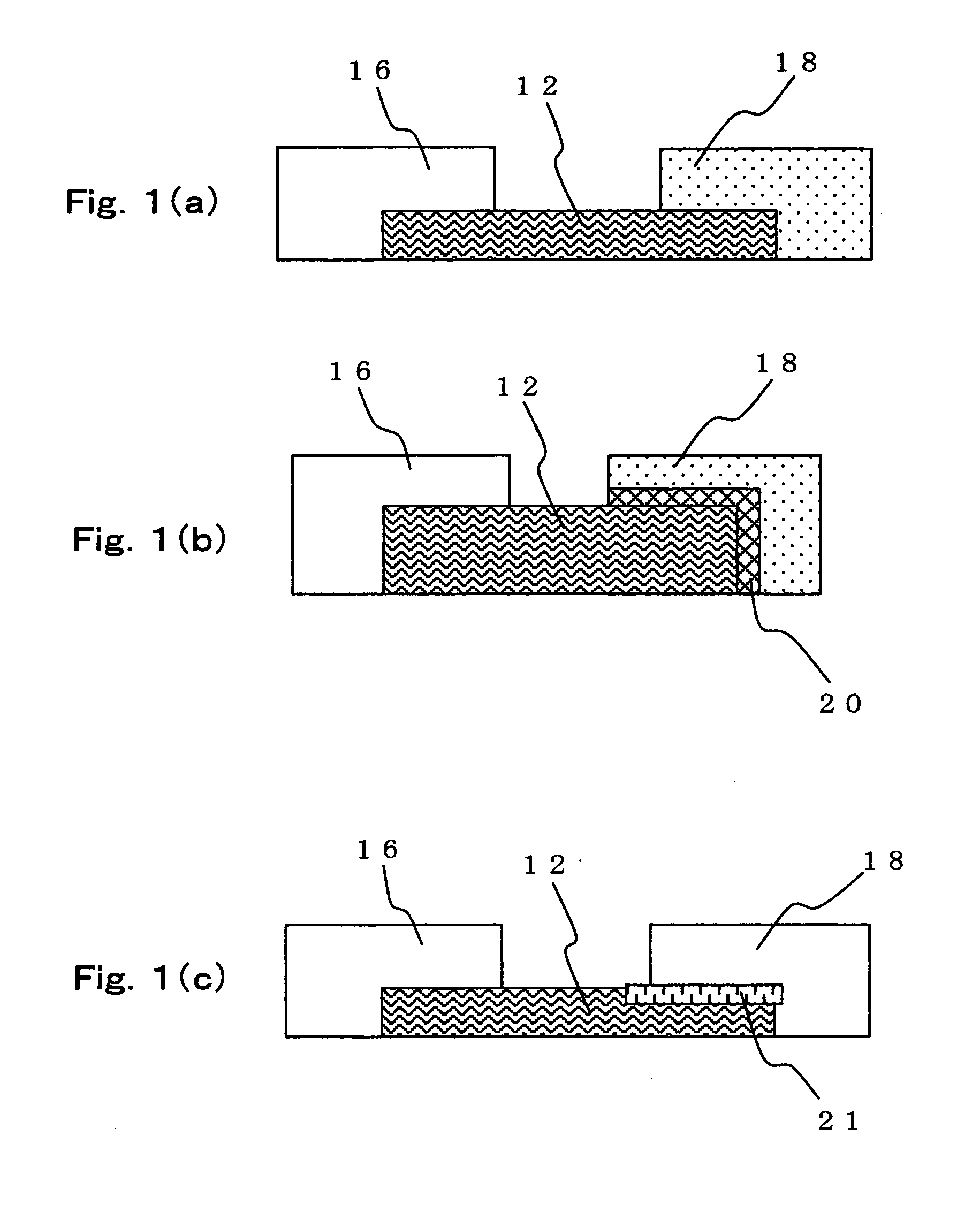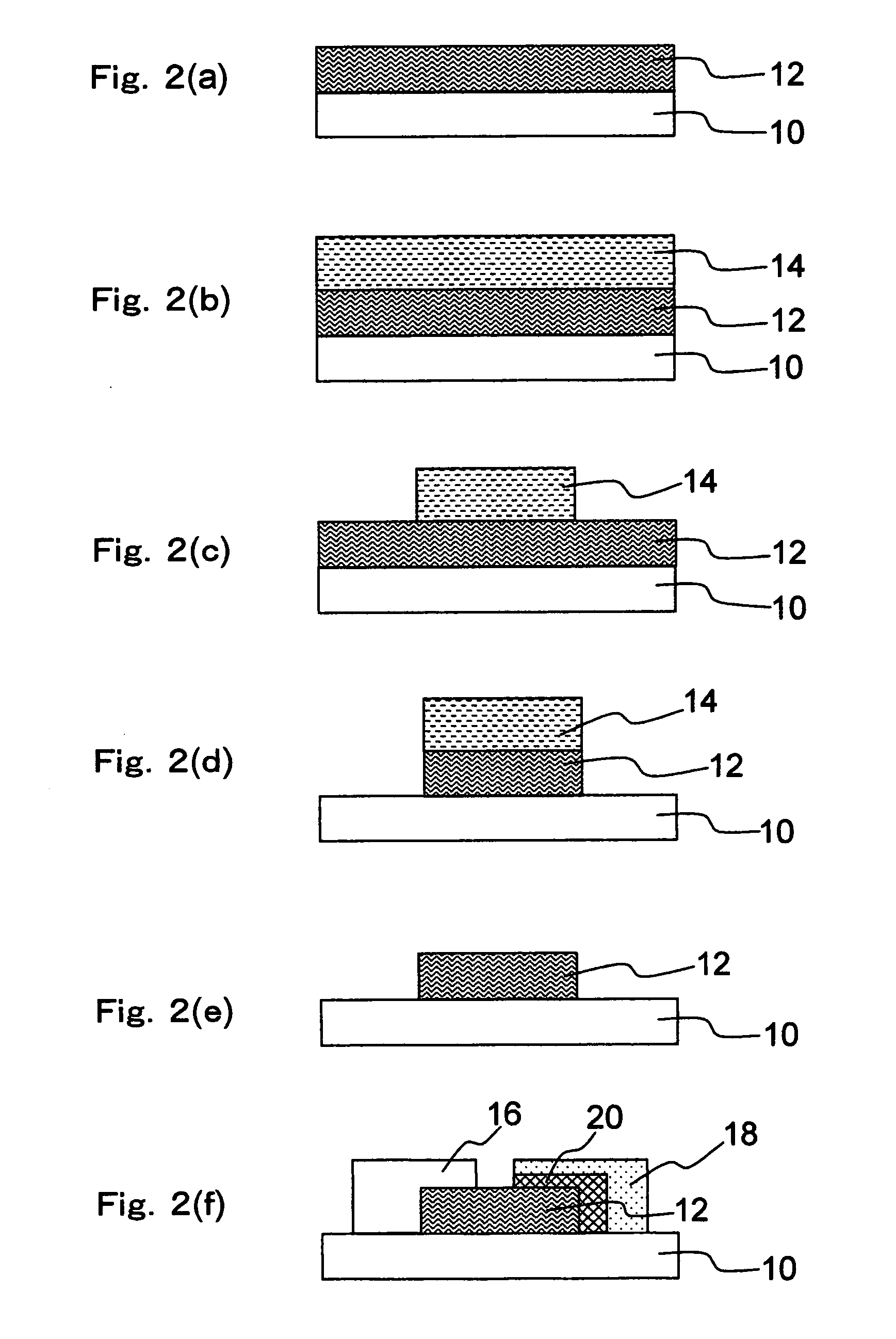Rectifying Device, Electronic Circuit Using the Same, and Method of Manufacturing Rectifying Device
- Summary
- Abstract
- Description
- Claims
- Application Information
AI Technical Summary
Benefits of technology
Problems solved by technology
Method used
Image
Examples
example 1
[0347]In this example, a rectifying device using a glycerin-cross-linked film of single-wall carbon nanotubes having semiconductor properties as a carrier transporter was prepared according to the flow of the method of manufacturing a rectifying device shown in FIG. 2. Titanium and aluminum were used as electrode materials to form electrodes. Aluminum was naturally oxidized to form an oxide film at an electrode-carbon nanotube structure interface. Reference numerals shown in FIG. 2 may be used in the description of this example.
(A) Supplying Step
(A-1) Preparation of Cross-Linking Solution (Addition Step)
[0348](i) Purification of Single-Wall Carbon Nanotube
[0349]Single-wall carbon nanotube powder (purity: 40%, available from Sigma-Aldrich Co.) was sieved (pore size of 125 μm) in advance to remove a coarse aggregate. 30 mg of the resultant (having an average diameter of 1.5 nm and an average length of 2 μm) were heated at 450° C. for 15 minutes by means of a muffle furnace to remove a...
example 2
[0377]A device using a cross-linked film of multi-wall carbon nanotubes as a carrier transporter was prepared according to the same method as that described in Example 1. An aluminum natural oxide film was formed as an oxide film at an interface between an aluminum electrode and a carbon nanotube structure in the same manner as in Example 1. Titanium was used as a material for the other electrode. A method of forming a coat is shown below. The other steps were the same as those of Example 1.
(A) Supplying Step
(A-1) Preparation of Cross-Linking Solution (Addition Step)
[0378](i) Addition of Carboxyl Group . . . Synthesis of Carbon Nanotube Carboxylic Acid
[0379]30 mg of multi-wall carbon nanotube powder (purity: 90%, average diameter: 30 nm, average length: 3 μm, available from Science Laboratories, Inc.) were added to 20 ml of concentrated nitric acid (60 mass % aqueous solution, available from Kanto Kagaku) for reflux at 120° C. for 20 hours, to synthesize a carbon nanotube carboxylic...
example 3
[0384]In this example, as shown in FIG. 6, a rectifying device having a sandwich structure in which a carrier transporter was sandwiched on a substrate was manufactured. FIG. 6 is a sectional diagram of the rectifying device of this example.
[0385]An aluminum electrode 3 serving as a main electrode was formed in advance on a silicon wafer (not shown) serving as a substrate. An alumina (Al2O3) layer 4 for forming a barrier was laminated by means of deposition on the aluminum electrode 3.
[0386]Next, in the same manner as in Example 1, a single-wall carbon nanotube structure 1 serving as a carrier transporting layer was formed. Furthermore, titanium / gold was deposited as an upper electrode 2 to manufacture a rectifying device. The deposited alumina had a thickness of about 70 nm.
[Evaluation Test (Measurement of Current-Voltage Characteristics)]
[0387]Direct current-voltage characteristics of the devices of Examples 1 to 3 were measured.
[0388]The measurement was performed according to the...
PUM
 Login to View More
Login to View More Abstract
Description
Claims
Application Information
 Login to View More
Login to View More - R&D
- Intellectual Property
- Life Sciences
- Materials
- Tech Scout
- Unparalleled Data Quality
- Higher Quality Content
- 60% Fewer Hallucinations
Browse by: Latest US Patents, China's latest patents, Technical Efficacy Thesaurus, Application Domain, Technology Topic, Popular Technical Reports.
© 2025 PatSnap. All rights reserved.Legal|Privacy policy|Modern Slavery Act Transparency Statement|Sitemap|About US| Contact US: help@patsnap.com



